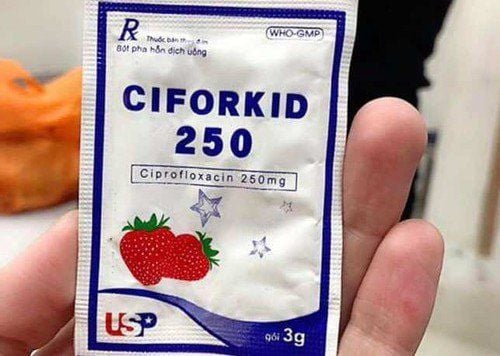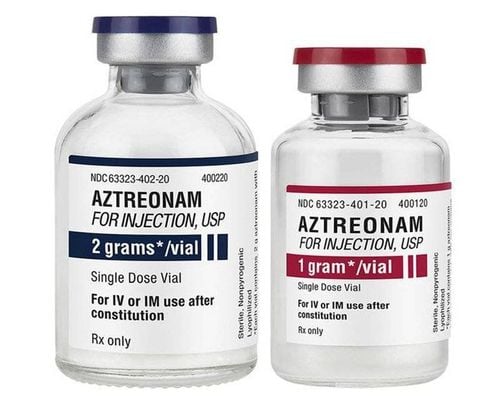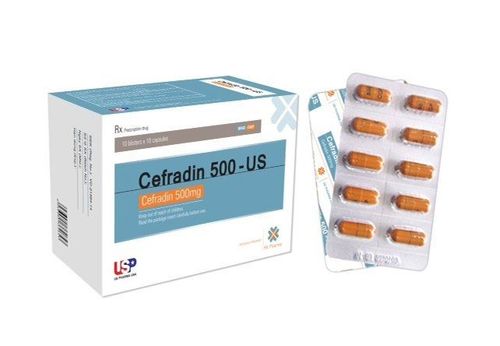This is an automatically translated article.
Cefoperazone is a 3rd generation cephalosporin antibiotic with bactericidal effect due to inhibition of bacterial cell wall synthesis. What are the uses, doses and precautions when using Cefoperazon Stada 1g?1. What is Cefoperazone 1g?
Cefoperazon Stada 1g drug has the main active ingredient is Cefoperazone, a 3rd generation cephalosporin antibiotic, which has a bactericidal effect by inhibiting the synthesis of the wall of the growing and dividing bacterial cell. The drug is in the form of a powder for injection.Cefoperazone is stable against beta lactamases formed in most gram-negative bacteria, so it has strong activity against gram-negative bacteria. Cefoperazone is also active against gram-positive bacteria such as Staphylococcus aureus, Staphylococcus epidermidis, Group A/B Streptococcus, Streptococcus viridans and Streptococcus pneumoniae. Besides, the drug is also effective on some anaerobic bacteria such as Peptococcus, Peptostreptococcus, Clostridium, Bacteroides.
2. Indications of Cefoperazon Stada 1g
Cefoperazone is indicated in infections caused by susceptible Gram-negative and Gram-positive bacteria and bacteria that are resistant to other beta-lactam antibiotics.
Upper and lower respiratory tract infections. Urinary tract infections. Peritonitis, cholecystitis, bile duct inflammation and other intra-abdominal infections. Sepsis Infections of the skin and soft tissues. Musculoskeletal infections. Pelvic inflammatory disease, endometritis, gonorrhea and other infections of the genital tract. Prophylaxis of postoperative infections in surgical patients
3. Contraindications of Cefoperazone Stada 1g
Cefoperazon Stada 1g, contraindicated in patients with hypersensitivity to the components of the drug or other antibiotics of the cephalosporin group.
4. Dosage and usage of Cefoperazone Stada 1g
4.1 Dosage Dosage will vary depending on the severity of the infection and the patient's condition. The doctor will prescribe the appropriate dose depending on each case. Below is the reference dose of Cefoperazone in some diseases:
Dosage in most cases of infection is 2-4g/day, divided into 2 times/day. In case of severe infection, the dose can be increased to 6-12g/day, divided equally into 2, 3 or 4 times. Urethritis not complicated by gonococcal infection: 500 mg single intramuscular injection is recommended. Patients with renal impairment: No dose adjustment is required when taking 2-4g/day. In patients with glomerular filtration rate less than 18 ml/min or serum creatinine > 3.5 mg/dl, the maximum dose is 4 g/day. Patients with liver disease or biliary obstruction: Do not take more than 4g/day. In the case of patients with both liver and kidney failure, the dose should not exceed 2 g/day, if higher doses are used, blood levels should be monitored. Infants and children: The recommended dose is 50–200 mg/kg/day every 12 hours. Prophylaxis in surgery 1-2 g intravenously 30-90 minutes before the start of surgery. In open-heart surgery, arthroplasty, prophylactic cefoperazone should be administered for 72 hours after completion of surgery. 4.2 How to use Cefoperazon Stada 1g is administered by intravenous infusion or intramuscular injection. Rapid intravenous administration is not recommended.
Intramuscular injection: Dilute Cefoperazon in 2 stages as follows:
Step 1: Add distilled water for injection into the 1g bottle of Cefoperazon Stada, shake well until the powder is completely dissolved. Step 2: Add Lidocaine to the vial and mix together Intravenous infusion : Dilute at least 2.8 ml for 1 g of cefoperazone. The entire freshly prepared solution should be further diluted in one of two ways:
Intermittent intravenous infusion: Cefoperazon Stada 1g solution will be further diluted in 20-40 ml of diluent per gram of drug and infused in 15-30 minutes. Continuous Intravenous Infusion: Cefoperazone Stada 1g should be administered as a continuous intravenous infusion after dilution to obtain a final concentration of 2-25 mg/ml.
5. Side effects of the drug Cefoperazon Stada 1g
Patients using Cefoperazone may experience the following side effects:
Common: Diarrhea, transient eosinophilia, positive Coombs test, skin rash. Uncommon: Fever, hemolytic anemia, reversible neutropenia, thrombocytopenia, urticaria, pruritus, transient pain at the injection site, phlebitis at the infusion site. Rare: Headache, convulsions, hypoprothrombinemia, nausea, vomiting, pseudomembranous colitis, erythema multiforme, Steven-Johnson syndrome, cholestatic jaundice..
6. Notes when using Cefoperazon Stada 1g
Before using Cefoperazone, a history of hypersensitivity reactions to cephalosporins, penicillins or other drugs should be checked. Dosage adjustment and plasma concentration monitoring is required in patients with concomitant renal and hepatic dysfunction.
Monitor vitamin K deficiency when using the drug for patients with malnutrition, malabsorption or alcoholism.
Hypersensitivity cross-reactions (including anaphylaxis) have been reported in some patients allergic to beta-lactam antibiotics. Therefore, Cefoperazone should be used with caution, monitored for signs and symptoms of anaphylaxis during the first administration, and available for emergency anaphylaxis. However, the rate of cross-allergy between Cefoperazone and penicillin is low.
Long-term use of cefoperazone may result in overgrowth of non-susceptible organisms. Therefore, it is necessary to monitor the patient carefully and discontinue the drug if superinfection occurs.
There have been cases of pseudomembranous colitis with the use of broad-spectrum antibiotics. Therefore, caution should be exercised when administering and treating metronidazole to patients with severe antibiotic-associated diarrhea. Caution should be exercised when prescribing broad-spectrum antibiotics to patients with gastrointestinal disease, especially inflammatory bowel disease.
Pregnant women: Cephalosporins are generally considered safe during pregnancy. However, because there are not enough rigorous studies in pregnant women, this drug should only be used in pregnant women if clearly needed.
Lactation: Cefoperazone is excreted in breast milk in low concentrations. Therefore, caution should be exercised when used in nursing mothers and observed for unusual symptoms in children such as rash, diarrhea.
7. Interactions of Cefoperazone Stada 1g
Drug interactions can lead to increased/decreased drug potency or increased toxicity. To prevent drug interactions, it is best for patients to inform their doctors and pharmacists of all prescription drugs, over-the-counter drugs, and dietary supplements they are taking. The following are some of the drug interactions of Cefoperazone that require clinical attention:
Disulfiram-like reactions with symptoms such as flushing, sweating, nausea, vomiting and tachycardia may occur if alcohol is consumed. within 72 hours of taking Cefoperazone. Concomitant use of cefoperazone and aminoglycosides may increase the risk of nephrotoxicity. Therefore, it is necessary to monitor the kidney function of patients, especially those who already have kidney failure. The antibacterial activity of Cefoperazone and Aminoglycosides may be additive or synergistic against some Gram-negative bacteria. However, there is a physical incompatibility between Cefoperazone and Aminoglycosides. Therefore, if the two drugs are used in combination, they must be used separately. Concomitant use of Cefoperazone with warfarin and heparin may increase the hypoprothrombinemic effect of Cefoperazone. The article has provided information on indications, dosage and notes when using Cefoperazon Stada 1g. Patients need to consult the drug god before using to ensure the safety and effectiveness of the drug.
Please dial HOTLINE for more information or register for an appointment HERE. Download MyVinmec app to make appointments faster and to manage your bookings easily.













